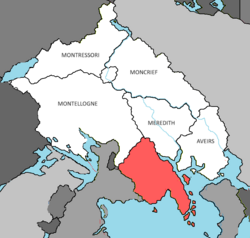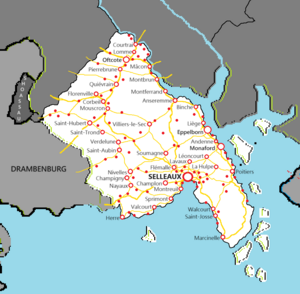Selleaux (province): Difference between revisions
No edit summary |
|||
| (One intermediate revision by the same user not shown) | |||
| Line 22: | Line 22: | ||
| government_type = | | government_type = | ||
| governing_body = | | governing_body = | ||
| leader_party = | | leader_party = Labour Party | ||
| leader_title = Governor | | leader_title = Governor | ||
| leader_name = | | leader_name = [[Arsène Larousse]] | ||
|leader_title3 = | |leader_title3 = | ||
|leader_name3 = | |leader_name3 = | ||
| Line 40: | Line 40: | ||
[[File:Picardy_countryside_(8930216616).jpg|thumb|left|Selleaux countryside]] | [[File:Picardy_countryside_(8930216616).jpg|thumb|left|Selleaux countryside]] | ||
==History== | ==History== | ||
Selleaux became a region of Avergnon at the conclusion of the [[Fifty Years War (Iearth)|Fifty Years War]] in 1389. Selleaux was contested over during the [[Drambenburg#Avergnon-Indiginous War (1750-1757)|Avergnon-Indiginous War]] (1750-1757) as disputes for [[Den | Selleaux became a region of Avergnon at the conclusion of the [[Fifty Years War (Iearth)|Fifty Years War]] in 1389. Selleaux was contested over during the [[Drambenburg#Avergnon-Indiginous War (1750-1757)|Avergnon-Indiginous War]] (1750-1757) as disputes for [[Den Haag]] and [[Chaesia]] ensued. | ||
During the industrial revolution, Selleaux became the manufacturing hub of Avergnon. Factories and shipyards funneled the economy, complimented with booming agricultural output, and Avergnon quickly became the richest nation in Euronia by 1830 due to Selleauxan industries. | During the industrial revolution, Selleaux became the manufacturing hub of Avergnon. Factories and shipyards funneled the economy, complimented with booming agricultural output, and Avergnon quickly became the richest nation in Euronia by 1830 due to Selleauxan industries. | ||
Latest revision as of 01:43, 23 July 2024
Selleaux
Selleaux | |
|---|---|
 Selleaux in Avergnon | |
| Country | |
| Capital | Selleaux |
| Largest city | Selleaux |
| Government | |
| • Governor | Arsène Larousse (Labour Party) |
| Population | |
| • Total | 18,878,200 |
Selleaux is a province of Avergnon located in the southernmost region of the country, with a coastline along the Siena Bay and hosting a border with Shoassau, the holy city of Montemera, and Drambenburg. The province has a population of 18.9 million people. Its provincial capital, largest city, and namesake is Selleaux, with other major cities including Monaford, Eppelborn, Saint-Hubert, and Oftcote.
Selleaux has two main geographical regions: the coastal basin plain, and the fertile inland plain. The first consists mainly of sand dunes and clayey alluvial soils in the polders. Polders are areas of land, close to or below sea level that have been reclaimed from the sea, from which they are protected by dikes or, a little further inland, by fields that have been drained with canals. With similar soils along the lowermost basin starts the inland plain, a smooth, slowly rising fertile area irrigated by many waterways that reaches an average height of about five metres (16 feet) above sea level with wide valleys of its rivers upstream as well as the Meine region to the west along the Drambenburgian border having sandy soils at altitudes around thirty metres.
Selleaux is regarded as a cultural center of Avergnon and Euronia, as its distinction from neighboring cultures have helped project a sense of nationality within the province. Selleaux is known as a center of knowledge, with many world class libraries, colleges, and debate houses located throughout the province. The province's vital connection to maritime industry makes it economically strategic for Avergnon, and shipping, manufacturing, and technology are key industries. Additionally, Selleaux has rich farmland and a thriving agricultural sector. Selleaux is well known for its vineyards and farmland, with larger vineyards often employing entire villages to cultivate and prune fields that are grown to keep pace with national and international demand of the famous Selleauxvian Wines.
Etymology
Geography
History
Selleaux became a region of Avergnon at the conclusion of the Fifty Years War in 1389. Selleaux was contested over during the Avergnon-Indiginous War (1750-1757) as disputes for Den Haag and Chaesia ensued.
During the industrial revolution, Selleaux became the manufacturing hub of Avergnon. Factories and shipyards funneled the economy, complimented with booming agricultural output, and Avergnon quickly became the richest nation in Euronia by 1830 due to Selleauxan industries.
Selleaux was invaded by Drambenburg in 1949, which began the World War. The Battle of Selleaux is regarded as one of the bloodiest battles of the war, occurring in the first month of the conflict and claiming the lives of nearly 100,000 soldiers. Selleaux was fully liberated by early June 1954, with the Battle of Saint-Hubert considered the last major clash in the Avergnonian front.
On June 13th, 2024, a highly disputed referendum for Selleaux to secede from Avergnon and cede to Drambenburg passed. The referendum was marred by irregularities, and the majority of the Selleaux population were seemingly unaware that it had been held until after it passed. Furthermore, polling of the Selleaux population indicated less than 25% support in favor of the referendum's passage, yet it cleared by 53%. Following the referendum, the Provincial Council of Selleaux instituted martial law, backed by Théo Barrault's administration, which in turn resulted in pro-Drambenburg protests, some of which turned violent. The referendum was illegal under the Constitution of Avergnon, and is not recognized by most countries. The ZIS and other WEDA intelligence agencies stated Drambenburgian espionage helped stage the referendum.
Government
Demographics
Cities
|
Cities in Selleaux province | |||||
| No. | CMA City |
Population | |||
| 1 | Selleaux | 3,228,000 | |||
| 2 | Monaford | 223,000 | |||
| 3 | Saint-Hubert | 187,000 | |||
| 4 | Eppelborn | 123,000 | |||
| 5 | Oftcote | 98,000 | |||
| 6 | Valcourt | 79,487 | |||
| 7 | Marcinelle | 75,342 | |||
| 8 | Saint-Aubin | 68,534 | |||
| 9 | Villiers-le-Sec | 67,343 | |||
| 10 | Flémalle | 62,432 | |||
| 11 | Corbeil | 58,382 | |||
| 12 | Herre | 56,431 | |||

